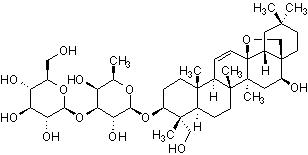All AbMole products are for research use only, cannot be used for human consumption.

Saikosaponin D inhibits cell growth of human cancer cells by inducing apoptosis and blocking cell cycle progression in the G1 phase.Saikosaponin D was found to stimulate corticotropin-releasing factor (CRF) gene expression and CRF release.Ssd was shown to increase cytosolic calcium level via direct inhibition of sarcoplasmic/endoplasmic reticulum Ca(2+) ATPase pump,leading to autophagy induction through the activation of the Ca(2+)/calmodulin-dependent kinase kinase-AMP-activated protein kinase-mammalian target of rapamycin pathway.Ssd treatment causes the disruption of calcium homeostasis, which induces endoplasmic reticulum stress as well as the unfolded protein responses pathway.Ssd also proved to be a potent cytotoxic agent in apoptosis-defective or apoptosis-resistant mouse embryonic fibroblast cells, which either lack caspases 3, 7 or 8 or had the Bax-Bak double knockout.SSd markedly suppressed phosphorylation of nuclear factor kappa B (NF-κB) and signal transducer and activator of transcription 3 (STAT3) and reversed the APAP-induced increases in the target genes of NF-κB, such as pro-inflammatory cytokine Il6 and Ccl2, and those of STAT3, such as Socs3, Fga, Fgb and Fgg. SSd also enhanced the expression of the anti-inflammatory cytokine Il10 mRNA.

Front Pharmacol. 2021 Feb 16;12:625074.
Saikosaponin D Rescues Deficits in Sexual Behavior and Ameliorates Neurological Dysfunction in Mice Exposed to Chronic Mild Stress
Saikosaponin D purchased from AbMole
| Molecular Weight | 780.98 |
| Formula | C42H68O13 |
| CAS Number | 20874-52-6 |
| Solubility (25°C) | DMSO |
| Storage |
Powder -20°C 3 years ; 4°C 2 years In solvent -80°C 6 months ; -20°C 1 month |
| Related COX Products |
|---|
| Sudoxicam
Sudoxicam is a reversible and orally active COX antagonist and a non-steroidal anti-inflammatory agent from the enol-carboxamide class. |
| Metyrosine
Metyrosine is a selective tyrosine hydroxylase enzyme inhibitor. Metyrosine significantly inhibits high COX-2 activity. Metyrosine exerts anti-inflammatory and anti-ulcerative effects. |
| PPOH
PPOH, a fatty acid derivative, is a selective cyclooxygenase (COX) inhibitor that inhibits arachidonic acid cyclooxygenase activity in renal cortical microsomes. |
| Tenidap
Tenidap, a non-steroidal anti-inflammatory drug, is a selective COX-1 inhibitor, with IC50 values of 0.03 μM and 1.2 μM for COX-1 and COX-2, respectively. |
| COX-2-IN-6
COX-2-IN-6 is an orally active, gut-restricted and selective cyclooxygenase-2 (COX-2) inhibitor for colorectal Chemoprevention of cancer. |
All AbMole products are for research use only, cannot be used for human consumption or veterinary use. We do not provide products or services to individuals. Please comply with the intended use and do not use AbMole products for any other purpose.


Products are for research use only. Not for human use. We do not sell to patients.
© Copyright 2010-2024 AbMole BioScience. All Rights Reserved.
